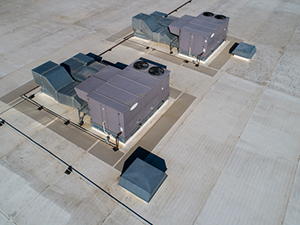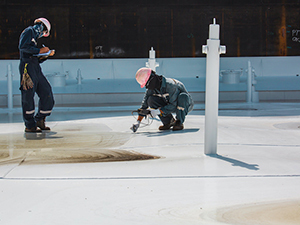
Commercial roof maintenance is essential for ensuring a building’s longevity, safety, and efficiency. As one of a structure’s most critical components, the roof not only shields the building from the elements but also plays a significant role in energy conservation. Routine upkeep helps avoid costly repairs, optimizes roof performance, and extends its lifespan. Below is an overview of why maintaining commercial roofs is so important, along with the key practices involved. For professional roof maintenance in Holmen, WI, call Golden Eagle Roofing at (608) 633-6719.
Why Commercial Roof Maintenance Matters
A well-maintained roof safeguards a building from water damage, leaks, and structural deterioration. Roof failures can lead to significant downtime, disrupt business operations, and incur expensive repairs. In addition, damaged roofs can cause safety hazards, such as falling debris or water accumulation, creating an unsafe environment for employees and customers.
Routine maintenance helps in identifying and addressing small issues before they become major problems. For instance, minor cracks, leaks, or debris buildup may seem insignificant, but over time, they can escalate into extensive damage if not addressed promptly. By investing in regular maintenance, businesses can save money by preventing expensive roof replacements or repairs down the line.
Key Components of Roof Maintenance
Inspection and Assessment

Regular roof inspections are the cornerstone of commercial roof maintenance. A professional roofer should inspect the roof at least twice a year, ideally in spring and fall. During inspections, technicians will check for signs of wear and tear, such as cracks, missing shingles, rust, or mold growth. They will also evaluate the condition of flashing, gutters, and drainage systems.
Cleaning
Keeping the roof clean is an essential part of maintenance. Debris such as leaves, branches, dirt, and moss can trap moisture and cause deterioration. In flat roofs, stagnant water can lead to leaks and pooling, whereas in sloped roofs, debris can obstruct the drainage system. Cleaning helps maintain proper drainage and prevents water damage.
Repairs
Any issues identified during inspections, such as small leaks, damaged shingles, or flashing problems, should be repaired promptly. Delaying repairs can lead to more considerable damage. Roof repairs might include patching cracks, replacing damaged shingles, or resealing joints and flashing.
Gutter and Drain Maintenance
Gutters and drainage systems play a vital role in directing water away from the building’s foundation. Regular cleaning of gutters ensures they are clear of debris and function properly. Clogged gutters can cause water to pool on the roof, leading to leaks and structural damage.
Preventive Treatments
Many commercial roofs benefit from preventive treatments such as coatings or sealants, which protect against UV damage, water infiltration, and other weather-related issues. These treatments can help prolong the roof’s lifespan and enhance its performance.
Roof Maintenance Experts
In summary, commercial roof maintenance is an essential practice that ensures a building’s roof remains functional, safe, and durable. Regular inspections, cleaning, repairs, and preventive treatments can save businesses money, reduce risks, and extend the lifespan of the roof. By investing in initiative-taking roof care, businesses can avoid costly disruptions and maintain a safe and efficient working environment. For roof maintenance solutions contact the team at Golden Eagle Roofing in Holmen, WI at (608) 633-6719.
FAQ
How often should commercial roofs be inspected?
It is recommended to inspect commercial roofs at least twice a year, typically in spring and fall. However, depending on your location and weather conditions, more frequent inspections may be necessary, especially after severe storms or extreme weather events.
What are the signs that my commercial roof needs repairs?
Signs that your roof may need repairs include visible water stains or leaks inside the building, missing or damaged shingles, cracks or blisters on the roof surface, clogged gutters, or the presence of mold and mildew. If any of these are present, it is important to schedule a professional inspection promptly.
Can I handle roof maintenance myself?
While routine cleaning, such as removing leaves and debris from gutters, can sometimes be done by building owners, it is best to leave inspections and more complex maintenance tasks to professional roofing contractors. They have the expertise and tools to identify hidden issues that may not be apparent to the untrained eye.
What are the benefits of preventive roof treatments?
Preventive treatments such as coatings or sealants can provide an extra layer of protection against UV rays, water infiltration, and weather damage. These treatments can help prevent deterioration, reduce maintenance costs, and extend the lifespan of the roof.
Can roof maintenance help reduce energy costs?
Yes! A well-maintained roof with proper insulation and sealants can improve the building’s energy efficiency. Preventing leaks and ensuring the roof is free from debris helps regulate indoor temperatures, which may reduce the need for heating or cooling, lowering energy costs.
